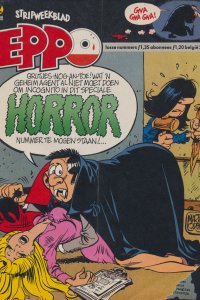Eppo
Editorial sections
In addition to comics, Eppo also offered readers various editorial sections. Eppovaria described current or popular scientific topics ("Of course you wear jeans sometimes! Well, then you should read this..."), the Eppopuzzel page offered rebuses and puzzles, and Eppop offered interviews with musicians. Many issues featured the 'Epposter' in the middle, which was often taken out of the magazine to hang on the wall.
Special editions
In addition to the magazine, the publisher soon began publishing albums of the most popular series. Special albums were also released with seven short stories. Eppo Ekstra, published in 1976, was the first, with complete comic strips of Lucky Luke, Trigië, De Generaal, Eppo and Agent 327. A second Eppo Ekstra appeared a year later, with ten short stories. In 1978, two Eppo albums were released as a reprint: readers could turn the book over and read some comics from the girls' magazine Anita.
Makeover
After six successful years, Eppo got a radical makeover. Starting with the first issue of 1983, the old logo was replaced by a more modern version and several purchased series appeared in the magazine, such as the Italian comics Tiki and Captain Rogers. Fortunately, new Dutch series continued to emerge. One of the most successful of these was Gilles de Geus (by Hanco Kolk), about a dimwitted highwayman. After 37 short stories, he also started drawing sequels based on a script by Peter de Wit, which made the comic enormously popular. The new comics Kanaal 13 (by Gerard Leever), De Familie Fortuin (by Peter de Wit) and the Alsjemaarbekend Band (by Evert Geradts) were also successful. However, the style of the magazine was strongly influenced by the caricatural style of most comics; realistic comics were increasingly in the minority.
Farewell
In week 33 of 1985, the last Eppo appeared; a week later, the magazine continued as Eppo Wordt Vervolgd, as a result of a proposed collaboration with the popular television program about comics presented by Han Peekel. The fact that this collaboration did not fully get off the ground led to the magazine being renamed Sjors & Sjimmie Stripblad in February 1988. Ten years later, the magazine quietly disappeared from view as Striparazzi, a monthly magazine of which only eight issues were published.














